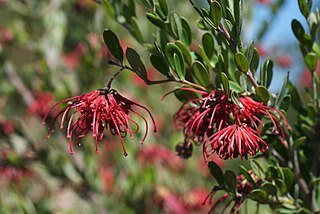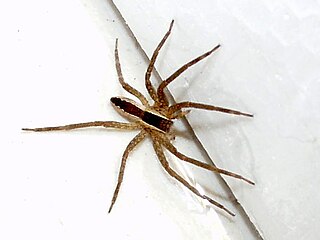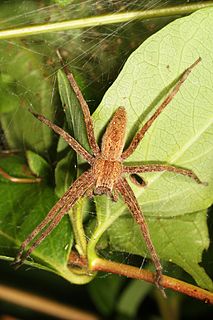
The chelicerae are the mouthparts of the Chelicerata, an arthropod group that includes arachnids, horseshoe crabs, and sea spiders. Commonly referred to as "jaws", chelicerae may be shaped as either articulated fangs, or similarly to pincers. Some chelicerae, such as those found on nearly all spiders, are hollow and contain venom glands, and are used to inject venom into prey or a perceived threat. For example, in Pisaurina mira, also known as the nursery web spider, the chelicerae is utilized to snatch the prey once it becomes within reach, facilitating the "sit-and wait ambush predator" behavior. Both pseudoscorpions and harvestmen have structures on their chelicerae that are used for grooming.

Nursery web spiders (Pisauridae) is a family of araneomorph spiders first described by Eugène Simon in 1890. They resemble wolf spiders (Lycosidae) except for several key differences. Wolf spiders have two very prominent eyes in addition to the other six, while a nursery web spider's eyes are all about the same size. Additionally, female nursery web spiders carry their egg sacs with their jaws and pedipalps instead of attaching them to their spinnerets as wolf spiders do. When the eggs are about to hatch, a female spider builds a nursery "tent", places her egg sac inside, and stands guard outside, hence the family's common name. Like the wolf spiders, however, the nursery web spiders are roaming hunters that don't use webs for catching prey. They have a wide variety of prey, and larger species may prey upon vertebrates, particularly amphibians and fish.

Libinia emarginata, the portly spider crab, common spider crab or nine-spined spider crab, is a species of stenohaline crab that lives on the Atlantic coast of North America.
Thianella is a possible monotypic genus of jumping spiders containing the single species, Thianella disjuncta. It was first described by Embrik Strand in 1907, and is found only on Java. Based on a male specimen, Roewer placed it close to Thiania, but his placements of salticids have often been questionable and no drawings currently exist. The name is an alteration of the salticid genus Thiania, and the species name is from Latin disiunctus "separated". The World Spider Catalog regards the genus and species names as nomina dubia.

Thiodina is a genus of jumping spiders that was first described by Eugène Louis Simon in 1900.

Philodromus is a genus of philodromid crab spiders. Spiders in this genus are distinctively flattened.

Grevillea speciosa, also known as red spider flower, is a shrub which is endemic to New South Wales in Australia.

Libinia dubia, the longnose spider crab, is a species of crab in the family Epialtidae. It is found in shallow waters on the eastern coast of North America.

Pisaurina mira, also known as the American nursery web spiders, is a species of spider in the family Pisauridae. They are often mistaken for wolf spiders (Lycosidae) due to their physical resemblance. P. mira is distinguished by its unique eye arrangement of two rows.

Pisaurina brevipes is a species of "nursery web spider" that is found in the eastern half of the North American continent, from Ontario down to Florida and west to Kansas.

Pisaurina is a genus of nursery web spiders that was first described by Eugène Louis Simon in 1898. It likes to live within vegetated areas such as meadows, bushes or tall grass, preferring warm or tropical areas to settle down and reproduce.
Collina glabicira is a species of Tasmanian orb-weaver spiders first described by A. T. Urquhart in 1891, and the only species in the genus Collina. It is known from a single female holotype that isn't among the types at the Canterbury Museum, nor was a plate of the figure ever printed. The original description alone is not enough to identify it, so this species and its genus is considered a nomen dubium.
Pisaurina undulata is a species of nursery web spider in the family Pisauridae. It is found in the United States and Cuba.
Mecaphesa dubia is a species of crab spider in the family Thomisidae. It is found in the United States and Mexico.

Trichopepla dubia is a species of stink bug in the family Pentatomidae. It is found in Central America and North America.
Plateumaris dubia, the long-horned leaf beetle, is a species of aquatic leaf beetle in the family Chrysomelidae. It is found in North America.

Spartocera is a genus of leaf-footed bugs in the family Coreidae. There are about 18 described species in Spartocera.
Seira dubia is a species of slender springtail in the family Entomobryidae.
Misodema is a genus of tropiduchid planthoppers in the family Tropiduchidae. There are at least two described species in Misodema.
Exodontha is a genus of soldier flies in the family Stratiomyidae. There are at least two described species in Exodontha.












